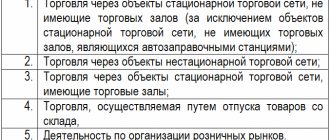The real tax burden is determined using the effective income tax rate. For domestic companies, the indicator allows you to quickly identify deviations from standard taxation and show accounting problems. Applying the settlement rate to foreign companies provides information about the level of control. The rate is determined as the average ratio of tax to enterprise income. This material will help you understand in more detail what an effective income tax rate is and what conditions exist for its payment.
The effective rate is calculated based on the results of the reporting period, the results of which the company submitted its reports. Control authorities use the indicator when preparing data to determine the need to audit domestic enterprises and the amount of taxation of controlled foreign companies (CFCs).
Effective income tax rate: what does the Federal Tax Service show for Russian enterprises?
The effective rate indicator is calculated when it is necessary to quickly determine the tax burden of an enterprise. Tax authorities, based on the data received, are preparing a plan for inspections of Russian enterprises. Features of using the indicator:
- Based on the calculation of the rate, the tax burden of domestic enterprises is determined.
- To control domestic enterprises, the calculation algorithm is used in relation to the main tax established depending on the adopted taxation regime.
- The calculation is made to obtain an express assessment of the deviation from the planned rate of 20% for income tax or 5 and 15% when paying a single tax.
The calculation of the effective rate is carried out by the audit departments of the Federal Tax Service when analyzing the activities of the enterprise. Limit indicators have been established; if these values are reduced, enterprises are subject to increased tax control. For trading companies, the rate should not be lower than 1%, for manufacturing enterprises – not lower than 3%.
Tax inefficiency: assessment and risks
The effective income tax rate is a quick and common way used by auditors to identify problems in a company's taxation.
An express assessment shows a deviation from plans or standards, for example, 20% for a general taxation system, 5 or 15% for a simplified one. An ineffective organization risks overpaying income taxes or losing in litigation. The situation can be improved by changing the accounting policy. At the same time, pay attention to the following:
- what expenses are not deductible and how large their volume is;
- how the authorized capital is formed and fixed assets are depreciated;
- how tax deductions and overpayments are administered;
- How large are the reserves for IT?
However, it is not worthwhile to optimize taxation using “gray” and “black” methods. The tax burden must be comparable to other enterprises in the industry - this is another criterion for tax authorities.
>What is the effective income tax rate
It is always necessary to know exactly what the effective income tax rate is and how it is calculated.
Use of rate information by internal users
The need to calculate the indicator also arises among internal users and auditors. Based on the obtained indicator, the responsible persons of the enterprise draw a conclusion about the possibility of optimization and reduction of the tax burden.
If the enterprise detects that the rate exceeds the planned indicator, optimization is carried out by changing the conditions of the accounting policy. Enterprises have the opportunity to change the conditions for accounting for income and expenses, methods for writing off inventory items, methods for determining depreciation, and the procedure for maintaining tax accounting in relation to differences.
Application of the effective tax rate for the valuation of foreign companies
The effective rate is used in international financial reporting. The data is used by foreign companies doing business on the international market and having representative offices or activities in the Russian Federation. In the Tax Code of the Russian Federation, the term arose in connection with the introduction of the concept of taxation of CFC profits. The size of the effective rate indicator allows you to determine:
- The degree of influence of taxation on the company's activities. The income of a non-resident enterprise is exempt from income tax in the Russian Federation, provided that the effective rate is determined in the amount of more than 75% of the weighted average rate.
- Taxation of a CFC that is not a resident in the Russian Federation, but receives income in the country. If the share of a Russian company is at least 25% or 10% with the total participation of residents in the amount of 50% of the total share of the capital of the CFC, the company pays profit in the part attributable to the share of residents.
- Taxation of a company with entirely foreign capital. The indicator is used in IFRS to legalize the withdrawal of company capital to offshore zones. The tax authorities of the Russian Federation use rate calculations to control the activities of foreign companies and simplify work with them.
Based on the results of the analysis of the indicator, the Federal Tax Service determines the amount of tax paid and the possibility of tax exemption for companies with foreign capital.
Formula for calculating the effective rate
The effective rate is determined at the end of the reporting period based on the financial statements submitted by the company. Enterprises that do not have reporting standards developed separately for the company present data in accordance with the requirements of IFRS. The fact that a foreign company belongs to a state with which there is no agreement on the exclusion of double taxation obliges the enterprise to submit reports in accordance with the provisions of the Tax Code of the Russian Federation.
To calculate the effective rate of profit, the formula is used: C = N / P x 100%.
| Index | Index decoding |
| WITH | tax rate |
| N | the amount of tax withheld from the income of the enterprise (profit before tax minus net profit); |
| P | the amount of profit received in the reporting period before tax |
Calculating the effective rate can be quite complex for companies in countries using progressive tax rates.
Calculation rules
If this indicator for finished reporting cannot be assessed objectively, then you can use the actual effective rate, which is calculated on the basis of the actual amount of tax from the beginning of the year to the current time. This allows you to more accurately estimate the annual tax rate. The degree of difference in the accounting of expenses and income between accounting and tax accounting is characterized by the size of the effective rate of organizations.
In Russia, there are several ways to calculate the effective income tax rate.
According to IAS 12 Income Taxes, the average effective income tax rate is the result of dividing income tax expense or income by accounting profit. This indicator is usually expressed as a percentage.
Formula for calculating the effective income tax rate
The “effective income tax rate” appeared in the Tax Code in January 2015. This was due to changes in the taxation of profits of foreign companies. The Tax Code of the Russian Federation states that this indicator is determined using the terminology of international accounting: EIT of a foreign organization is the amount of tax withheld from income and income tax withheld from profit, which is divided by the amount of income of the foreign company. The amount of income is determined in one of the following ways:
- according to reporting data for the financial year, which is prepared in accordance with the law of the country in which the company is registered;
- according to the rules established by Chapter 25 of the Tax Code of the Russian Federation for taxpayers - Russian organizations (Article 25.13-1 of the Tax Code of the Russian Federation).
The Federal Tax Service uses a method close to the “tax burden”: the current tax is divided not by profit, but by revenue.
note
An effective income tax rate is an express analysis that allows not only to identify the company’s problems, but also to determine the quality of work of employees responsible for tax accounting.
Determining profit before tax according to RAS is not always effective, since the data obtained may not fully reflect the real situation. In this regard, most companies use profit indicators according to IFRS or management accounting.
Unlike RAS (PBU 18/02 “Accounting for corporate income tax calculations”), IAS 12 is based on a real accounting of the current state of affairs of the enterprise. After all, the main differences in the accounting principles of RAS and IFRS are the methods of assessing assets and liabilities, as well as the correlation of expenses and income with the reporting period. The application of these standards can change the company's position in the eyes of reporting users. The choice of format can make the real picture more optimistic or, conversely, negative.
Payment of profit calculated at the effective rate
The value of the effective CFC rate indicator is compared with the weighted average value. Enterprises of foreign jurisdiction do not pay tax if the effective rate reaches 75% or exceeds the figure. In this case, the company is not controlled and subject to income tax.
To obtain an exemption, additional conditions must be met: the country of residence of the foreign company must have an agreement with the Russian Federation on the elimination of double taxation and exchange tax information with domestic control authorities. Otherwise, the result of the company’s financial activities will be taxed under the laws of the Russian Federation.
Income tax payers in 2022
Payers of income tax are:
- Russian companies;
- foreign companies that receive income in the Russian Federation and operate through permanent representative offices.
Tax agents also withhold income tax from the income of foreign companies that have not opened representative offices in the Russian Federation. For example, these tax agents are:
- Russian legal entities;
- IP.
Profit tax is not paid:
- taxpayers using the simplified tax system and unified agricultural tax, because they pay other taxes;
- Skolkovo residents, since their profits are exempt from taxation.
Ratio of effective and weighted average rates
The weighted average rate affects all categories of profit received by the company. For example, when receiving profit from dividends, the weighted average rate is calculated according to the algorithm: Svz = (P1 x C1 + P2 x C2) / P1 + P2.
| Index | Index decoding |
| Svz | Weighted average rate |
| P1 | The amount of net profit received |
| P2 | Amount of dividends paid |
| C1 | Profit tax rate |
| C2 | Dividend tax rate |
An example of comparing the effective rate with the weighted average:
At the end of the reporting period, the company had a profit after tax in the amount of CU 150,000; dividends paid at the end of the period amounted to CU 21,000. The CFC tax amounted to 12,000 USD. To obtain data on the need for taxation, the following indicators are calculated:
- Effective rate: Se = 12,000 / 150,000 x 100% = 8%;
- Weighted average rate: Свз = (138,000 x 20% + 12,000 x 13%) / 150,000 x 100% = (27,600 + 1560) / 150,000 x 100% = 19.4%;
- We determine the bet ratio: CC = 8 / 19.4 x 100% = 41.2%.
Conclusion: the ratio of the effective rate to the weighted average was 41.2%, which is less than 75%. Businesses are subject to taxation in the country under controlled foreign companies.
Reasons for the differences between effective and weighted average types of rates
Enterprises may have differences in effective and weighted average rates due to the peculiarities of conducting business and accounting for financial elements of reporting. In accounting, there are several possible reasons for discrepancies in indicators.
| Condition | Detailed characteristics |
| Differences in the procedure for generating accounting and tax profits | Differences arise when different standards are used for taxation and financial performance. The use of indicators allows you to pursue different goals - to show financial stability and reduce taxation |
| Using Tax Credits | Tax credits can reduce the effective rate to the weighted average |
| Using deferred income tax payments | When deferring tax payment to a future period, the effective rate in the current period will decrease relative to the weighted average, and in future periods it will increase |
Marginal effective rate
Many countries practice a rather unique tax system called “progressive”.
The greater the income of an individual or legal entity, the higher the tax rate applied. And vice versa: the lower the total income, the lower the tax rate.
The rate applied to the maximum portion of a taxable person's income is called the marginal rate. The marginal tax rate is used to calculate the marginal effective rate.
In one European country the tax rate is:
| Money limit | Bet size |
| Income less than 15 thousand dollars | 20% |
| Income amount from 15 thousand dollars to 40 thousand dollars | 30% |
| Income is more than 40 thousand dollars | 40% |
The marginal effective rate in this case is 40%.
Who pays monthly advance payments for income tax, see the article: advance payments for income tax.
A sample payment order for income tax is available.
How can you legally reduce your income tax? .
In order to optimize your production and income, you need to understand all the intricacies of tax legislation.
Many of its aspects can significantly reduce the amount required to pay taxes.
Ignorance of current laws leads to various fines, as well as a decrease in the organization’s income and profitability.
Previous article: Optimization of income tax Next article: IFRS 12 for income tax
Payment of tax by a controlled company upon loss
A company operating on the international market may suffer a loss at the end of the reporting year. When calculating the profit of a CFC, the conditions of Art. 309.1 Tax Code of the Russian Federation. If, at the end of the reporting period, the company received expenses lower than income, no tax is paid. Losses received by controlled enterprises with foreign capital are not carried forward to future periods. Foreign-based enterprises that have zero profit or losses are classified as controlled.






